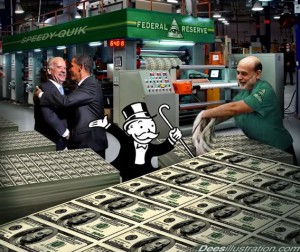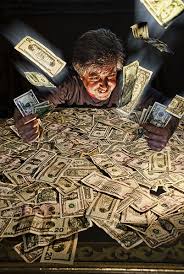The US Bond Market Bubble May Blow
The US Bond Market is far Larger than the Stock Market: If Even Part of it Blows, it’ll Dig a Magnificent Crater
by Wolf Richter •
“So, if rates rise, we get nervous. If rates fall, we get nervous. If rates stay the same, we get nervous. When don’t we get nervous? Raise the rates already! We are talking an idling .25% not 3.5% where we should be to make saving pay, and borrowing a cautionary endeavor as it should be!”
That’s the lament posted by a WOLF STREET commenter on Monday afternoon. here
“Perhaps investors are getting nervous because the price action is so bad,” explained DoubleLine Capital CEO Jeffrey Gundlach on Monday about the selling pressures junk bonds have come under after Fed Chair Janet Yellen’s press conference, which had been, in his words, “a little bit of a debacle.”
He complained that Yellen had thrown uncertainty and confusion over financial markets, as Fed heads “kind of no longer have a framework” to go by.
He’s always talking up his $80-billion book, which is full of bonds. He has a lot to lose when rates rise and bonds decline in value. So he said that raising rates this year would be a “policy mistake.”
It certainly would be for him, having ridden the greatest bond bull market all the way to its peak while extracting a ton of fees along the way.
Bond-fund managers like Gundlach already had a few scares to deal with, including the “Taper Tantrum” in the summer of 2013 in reaction to the Fed’s discussions on tapering QE Infinity out of existence, then the “flash crash” in the Treasury market last October 15, and for the past year, the not-so-flash crash in energy junk bonds.
Folks have reason to be nervous about bonds.
Bonds are supposed to be a conservative investment, safer and more predictable than stocks and a host of other asset classes. But bonds are on edge, and investors can see it. And they can see the sheer magnitude of it.
In 2000, the US stock market was valued at $15 trillion and the US bond market at $17.3 trillion, according to the Wall Street Journal. By this year, US stock market capitalization has jumped 76% to $26.3 trillion. But bond market capitalization has soared 125% to $39.5 trillion.
That increase in the bond market was driven largely by enormous, record-breaking issuance by corporate and government entities.
But there’s even more: an additional $9.6 trillion of US-dollar-denominated bonds issued by corporations and governments outside the US. Just paying interest on this debt is going to be a herculean task where local currencies, as in Brazil, have plunged against the dollar [read…World Is Now “More Exposed than Ever” to Explosive Dollar].
So, $50 trillion of dollar-denominated bonds (not counting other debt, such as loans, and products based on them, such as Collateralized Loan Obligations).
These bonds are now perched precariously on edge, after a three-decade bond bull market that culminated with seven years of interest rate repression and QE which pushed yields of even the riskiest junk to ludicrously low levels and prices into the stratosphere. If even part of the bond market blows, given its magnitude, it’s going to dig a magnificent crater.
Amidst the Fed’s cacophony and flip-flopping about raising rates, Fed heads are coming out and putting a rate hike this year back on the table, thus turning this whole thing into a comic zoo, and it would be truly hilarious, if it weren’t for, among other things, the $50 trillion in bonds….
Higher rates could knock already stressed corporate and municipal borrowers off their feet. But it would come at the worst possible time, now that bonds of all kinds have migrated more and more into bond mutual funds and ETFs. Retail investors have poured $1.5 trillion into these funds since 2007 (compared to $829 billion they poured into stock funds over the same time). Bond funds now own 17% of all corporate bonds, nearly double from just before the Financial Crisis.
A portion of these bonds are junk bonds. In the era of near-zero interest rates, bond-fund managers have bought the riskiest bonds so that their slightly higher yields would infuse some oomph into their funds. Many of these junk bonds are now slated for destruction, with energy junk bonds already there.
But this concentration of ownership by bond funds poses its own issues, including larger price drops during times of stress. The Wall Street Journal:
Domestically, the rise of large bond funds has created new risks. As the funds have grown, so has cross-ownership of the same bonds, increasing the likelihood of contagion if one manager starts selling, the International Monetary Fund says. Regulators worry that many investors may not know what is in their funds. A market downswing could lead to rising redemptions of fund shares, prompting funds to sell assets to raise cash and amplifying selling pressure across the market.
Treasuries might not be spared the selloff either. But in the short term, they might be winners if investors get cold feet with their other instruments of capital destruction. Even a small sell-off, whether in stocks or bonds, sends investors scurrying in search of perceived safety. Even during the mini-swoon today, with the S&P 500 down 1.6% and the Nasdaq down 2% as I’m writing this, Treasuries suddenly look appetizing, prices rise, and yields fall. And for now, the 10-year yield has dropped 8 basis points to 2.12%, despite the Fed rate-hike cacophony.
But the Fed has offered no “satisfactory answer” why it’s still “stuck in emergency mode,” explained St. Louis Fed President James Bullard to distance himself from this debacle. Read…Bullard Fires Broadside at Fed, Shrapnel Hits his Foot



Leave a Reply